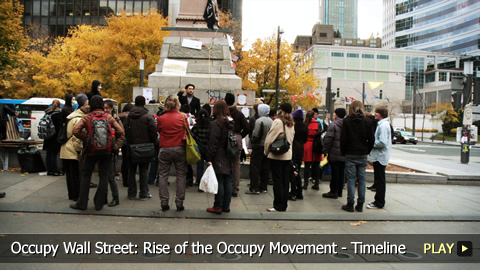Occupy Wall Street: Rise of the Occupy Movement - Timeline

The Rise of the Occupy Movement
This international protest movement became one of the biggest news stories of 2011. Welcome to WatchMojo.com, and today we’ll be learning about the rise of the Occupy movement.
Arab Spring
At the end of 2010, a series of uprisings in the Arab world began and these revolutions served to change the status quo. This movement was referred to as the Arab Spring, and it inspired the Occupy movement in 2011. However, while the Arab Spring often resulted in violence, Occupy aimed for peaceful protests and occupations.
The Goal
The main goal of the Occupy movement was to address the disparity in wealth distribution that existed in societies around the world, and to challenge the influence corporations had on democracy. Early on, media found it difficult to pinpoint a clear-cut set of demands or ideals for the group. And, in fact, some saw the Occupy movement as a direct rejection of the direction of society as a whole, and not simply a financial problem. However, anti-consumerist group Adbusters eventually suggested a “Robin Hood” tax as a goal for the group.
Unemployment
The Occupy movement was made up of a variety of different types of people: however, the most common theme was unemployment.
We are the 99%
One of the rallying cries of the group has been the motto “We are the 99 per cent.” This referred to the wealth distribution between the majority of the population and the top richest percentile.
A Worldwide Protest
The movement began to gain momentum in mid-May in Spain, after protests and demonstrations towards similar beliefs took place. By the end of that month, it was suggested that a worldwide protest was necessary, scheduled for October 15th, 2011.
Occupy Dataran
A few months later, Adbusters lent its support to that idea, and suggested the occupation of Wall Street as a symbol of corporate greed. It was around this time that the first Occupy camp was set up in Kuala Lumpur: Occupy Dataran began on July 30th, 2011.
Anonymous
Another group that supported the Occupy movement early on was Anonymous. This international hacking group promoted the idea of full-scale occupations involving tents, kitchens and communities in occupied areas. They were also instrumental in promoting the idea to their followers.
Occupy Wall Street
On September 17th, Occupy movements popped up on both Wall Street in New York City and in San Francisco. These were the installations of Occupy that really earned the movement widespread publicity. The movement grew exponentially from there and on October 15th, protests took place as planned around the world based on the same beliefs. By the end of that month, over two thousand cities across the globe were housing Occupy sites.
Bank Transfer Day
The Occupy movement grew organically, and with great help from the Internet and social media. A related idea popped up in November: Bank Transfer Day called on consumers to transfer their money out of big banks to smaller credit unions. This idea was sparked by Bank of America’s and Wells Fargo’s choices to begin charging fees for debit card use. The bad publicity caused the banks to ditch the idea. Bank Transfer Day took place on November 5th and resulted in an estimated 40 thousand joining credit unions on that day alone.
Losing Steam
After a month of widespread protests, some condemned Occupy for losing focus and support. Other movements joined forces with Occupy, but ultimately served to dilute an already unclear set of demands. Anarchists, communists, and others were reportedly using Occupy as a mask for their own beliefs and activities. The movement was also criticized for its hygiene, and many of the tented communities became makeshift homeless shelters.
Forced Evictions
As the protests progressed, city officials and police around the world lost patience and attempted to evict the occupiers, sometimes by force or by violent means. By mid-November, many groups were being driven out of occupation.
Important News Story
Whether or not the Occupy movement does manage to change the system, there is no denying it was one of the biggest news stories of 2011.
